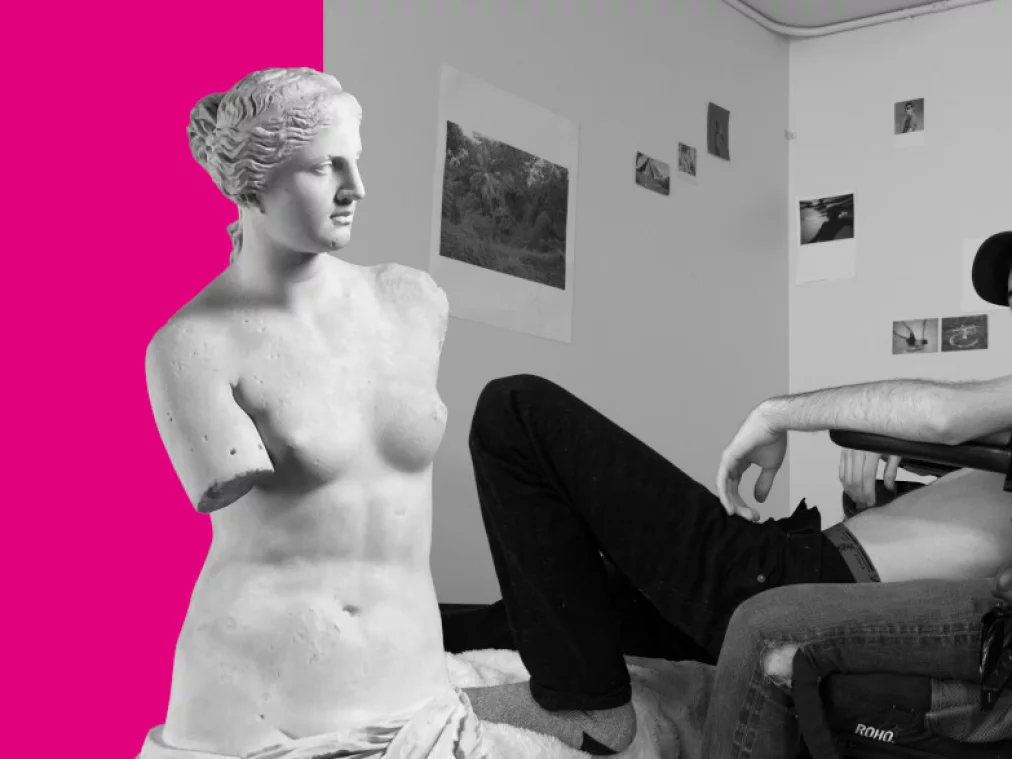Opening: Queering the Crip, Cripping the Queer | 1.Sept | SCHWULES MUSEUM – Sophiensæle | Independent Theater in Berlin
Vernissage

“Sexual minorities and people with disabilities share a history of injustice: both have been pathologized by medicine; demonized by religion; discriminated against in housing, employment, and education; stereotyped in representation; victimized by hate groups; and isolated socially, often in their families of origin.” – Carrie Sandahl
One week before the kick-off of our performance festival Queering the Crip, Cripping the Queer, the Schwule Museum opens their exhibition of the same name. The exhibition opens diverse perspectives on history, culture, and activism at the intersection of queerness and disability. With a warm welcome by the SMU and opening speeches from the curators Kenny Fries and Birgit Bosold, we want to dedicate the evening to this unique show.
Queering the Crip, Cripping the Queer is the first international exhibition to explore the multiple historical, cultural, and political intersections of queerness and disability. The exhibition counters the fantasy of “the ideal body” with artworks by 24 international contemporary artists. By juxtaposing historical objects with contemporary drawings, paintings, photographs, mixed media installations, performance videos, and audio works, curators Birgit Bosold, Kate Brehme, and Kenny Fries highlight how queer/disabled artists reclaim the historical narrative with agency and pride. Find more information about the exhibition here.
The museum is accessible by public transport (details provided below). There are no barrier-free parking spaces in the area.There are a few public paid parking spaces in the immediate area.
Step-free entry for all visitors is possible via the courtyard. Please use the open gate to the left of the main entrance door. The entrance door to the museum is located on the right and will be open too. If you encounter any problems ring the bell, or ring the contact phone number: 030 69 59 92 62
The path into the courtyard is paved. It has a slight incline of less than 5%. The entrance is the first door on the right. This is the café. Wheelchairs or walking aids can be parked in a guarded area. The exhibition rooms, café and library are accessible at ground level or via ramps and lifts. There are two wheelchair-accessible toilets with fold-up grab bars. The movement areas of the toilets are 130 x 150 cm in front of the WC. The toilet in the foyer has 70 x 90 cm space to the right of the WC. The toilet between rooms 3 and 4 has 70 x 90 cm space to the left of the WC. The exhibits and information are mainly visible while sitting down. The doors and passages in the museum are at least 90 cm wide. Access to the library is also via the courtyard. In the courtyard, please ring the bell a second time at “Museum Verwaltung”. Take the lift to the 1st floor. The lift door is 90 cm wide, the cabin 110 x 140 cm deep. The movement area in front of the lift is 150 x 130 cm.
Other information
There is a cloakroom with lockers. Assistance dogs are permitted in all rooms. The entrance is not designed to be visually contrasting. Toilets are all-gender and single cubicles usable by function. The exhibits are generally well lit. Information on the exhibits is provided in writing and is mostly visually contrasting.
Interpretation
Information on exhibits is available as video in German Sign Language. For Queering the Crip, Cripping the Queer we offer guided tours in DGS every month. Guided tours in DGS can also be booked for groups. It is possible to book guided tours of all exhibitions in German spoken language with DGS interpretation. There are no additional costs. Acoustic information is in most cases accessible via texts. Information is not available in Braille or prismatic writing but there is an audio-guide and a number of tactile interpretations of artworks. A summary of the exhibition is available in simple language. There are no guided tours for visually impaired and blind people offered so far. On request, we offer DGS interpretation for booked tours. On request, we offer Phonak devices for hearing assistance during tours and events. The hearing assistance is usable with headphones or via T-coil with the hearing aid.
Schwules Museum strives to make information on barriers transparent and is working to reduce them further. If you have any tips or questions, please feel free to contact them: kontakt@schwulesmuseum.de or call 030 69 59 90 50
Public Transport
U Nollendorfplatz: U1, U2, U3 & U4, Bus M19, 106 & 187
U Kurfürstenstraße: U1
Lützowstraße/Potsdamer Straße: Bus M48 & M85
